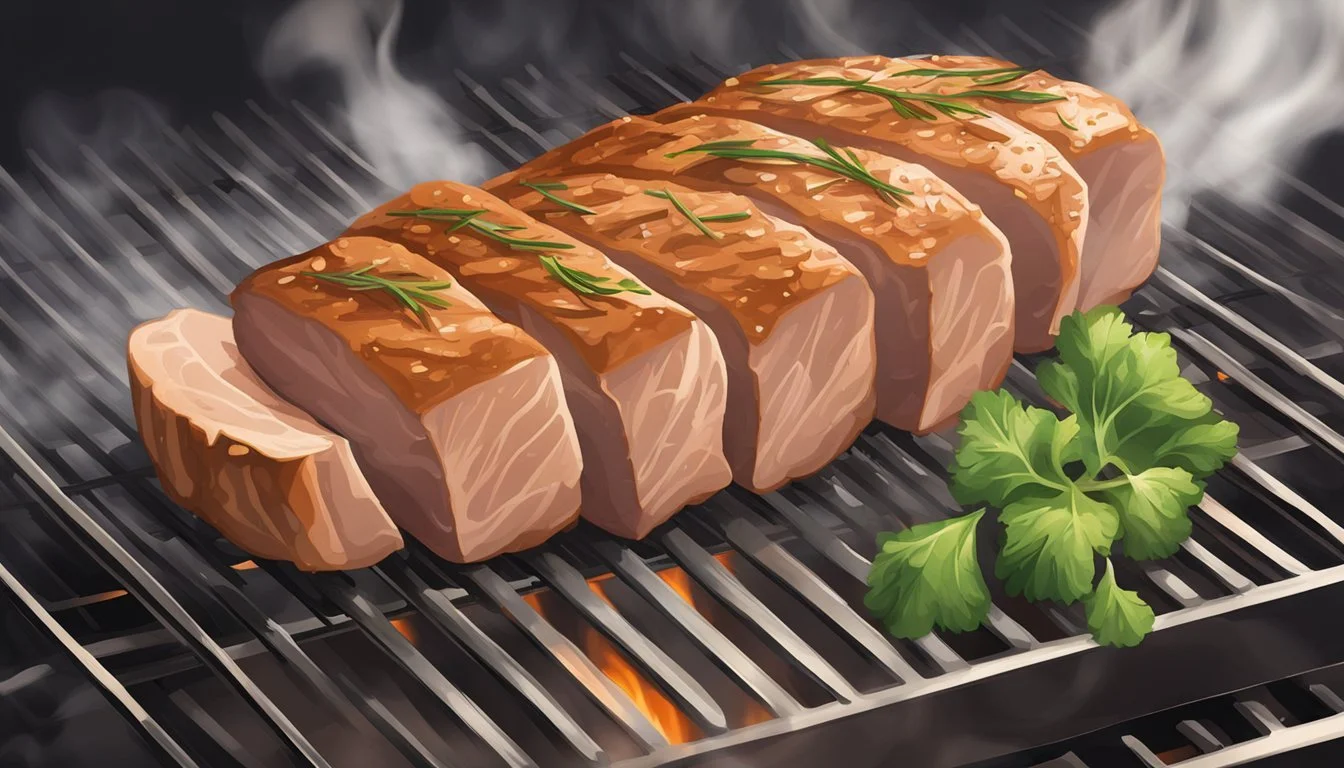Smoking a Bone-In Pork Loin
How to Smoke a Bone-In Pork Loin for Maximum Flavor
Smoking a bone-in pork loin is an art that transforms a simple cut of meat into a succulent feast with layers of smoky flavor. The process begins with selecting a high-quality pork loin, ensuring it has the rib bone intact, which contributes to the overall tenderness and moisture of the meat during the smoking process. To achieve maximum flavor, a combination of a brine solution and a spice rub can be applied, laying the foundation for a rich taste experience. The brine, typically comprising apple juice, salt, sugar, and sometimes herbs, infuses the meat with extra flavor and helps to ensure a juicy result.
Before the loin meets the smoker, it’s essential to trim any excess silver skin and connective tissue with a sharp paring knife for an even cook. A pellet smoker filled with your favorite wood chips, like apple wood or cherry, is ideal for this task, providing a consistent and flavorful smoke. Apple pellets, in particular, are known for imparting a subtle, fruity smokiness that complements the pork superbly. The pork loin should be smoked over indirect heat — a method by which hot spots in the smoker are minimized and the meat cooks evenly through a gentle infusion of smoke.
The internal temperature is key to perfect doneness; a digital or probe thermometer is indispensable to monitor this. The meat should be smoked until it reaches the safe internal temperature of 145°F, which usually takes about 2-3 hours, depending on the size of the loin. During the cooking process, maintaining a preheated smoker at a medium heat through careful heat control ensures that every savory bite of the pork loin has the fragrant, smoky essence and a tender texture that delights the entire family. After smoking, wrapping the loin in aluminum foil and allowing it to rest lets the juices redistribute, which makes for a more mouthwatering serving.
Selecting and Preparing the Pork Loin
The journey to a mouth-watering, smoked bone-in pork loin begins with a careful selection of meat and a thorough preparation process. Ensuring proper trimming, brining, and seasoning will provide a foundation for a sumptuous smoky dish.
Choosing a High-Quality Bone-In Pork Loin
Look for a 3-4 pound pork loin with the rib bone intact, as bone-in cuts tend to yield more flavor during cooking. The meat should have a pinkish hue and be firm to the touch. It's essential to select pork that has a small amount of marbling for moisture during the long smoking process while avoiding cuts with an excessive amount of fat or connective tissue.
Trimming Excess Fat and Silver Skin
Once the pork loin is selected, prepare it by trimming off any excess fat, leaving about a 1/4-inch layer to render down and keep the meat moist. Use a sharp paring knife to remove the tough silver skin, as it does not break down during cooking and can result in a chewy texture. The goal is to create a clean surface for the brine and spice rub to make contact.
Applying a Dry Brine or Wet Brine
A dry brine of kosher salt (how long does kosher salt last?) and spices like garlic powder, (how long does garlic powder last?) applied directly to the meat and left to rest, wrapped in plastic wrap for 2-3 hours, can enhance the pork's moisture retention. Alternatively, a wet brine—a brine solution consisting of cold water, salt, and optional flavorings such as apple juice, hot sauce (how long does hot sauce last?), or herbs—can be used to immerse the pork loin overnight. This will tenderize the meat and infuse it with extra flavor.
Note: During the smoking process, aim for an internal temperature of 145°F, as measured with a digital thermometer, to ensure the pork loin is cooked to perfection.
Preparing the Smoker
Before smoking a bone-in pork loin, it's crucial to set up the smoker correctly. The correct wood choice and temperature are paramount to infuse the meat with a rich, smoky flavor while cooking it to the perfect tenderness.
Choosing the Best Wood for Flavor
When smoking pork, the type of wood used can significantly impact the flavor profile of the meat. Hardwoods such as apple wood are popular for their sweet, mellow smoke that complements pork without overpowering it. For a deeper smoky flavor, hickory can be a good choice—it pairs well with pork and imparts a stronger, bacon-like taste.
Recommended Woods:
Apple Wood: Delivers a sweet, fruity smoke.
Hickory: Provides a stronger, more traditional BBQ smokiness.
In smoking, the wood can come in the form of chips or pellets, with pellets being especially common in pellet smokers. Ensure that your chosen wood is dry and seasoned for optimal smoke production.
Maintaining Proper Temperature and Smoke
Controlling the temperature is key to the smoking process. Aim to preheat the smoker to a consistent temperature range of 225-250°F. This range is optimal for breaking down the connective tissue in the pork loin, resulting in tender meat. Smoking with indirect heat is essential to avoid overcooking the exterior of the pork loin.
A digital thermometer or probe thermometer should be used to monitor the internal temperature of the meat. Place it away from the bone to get an accurate reading. The pork should be brought to an internal temperature of 145°F—the safe minimum for pork to ensure it is cooked through but remains juicy.
Temperature Tips:
Use a probe thermometer to keep track of the internal temperature without frequently opening the smoker, which can cause temperature fluctuations.
Look out for hot spots in gas grills and manage them by rotating the meat if necessary.
Maintain medium heat and avoid temperature spikes to ensure even cooking.
The smoker should produce a steady stream of flavorful smoke. It shouldn't be billowing out thick white clouds, which can indicate incomplete combustion and impart a bitter taste. Instead, aim for a thinner blue smoke which indicates clean combustion and better flavor saturation.
By meticulously setting up the smoker with the right wood and maintaining the proper temperature, your smoking process will impart a range of succulent layers of flavor to the bone-in pork loin, creating a meal that delights the entire family.
Smoking Pork Loin for Flavor
Smoking a bone-in pork loin requires attention to seasoning, internal temperatures, and the finishing touches that contribute to a well-rounded smoky flavor. This section details each critical step to achieve the best possible results.
Rubbing on Spices and Herbs
Begin by patting the pork loin dry with paper towels, ensuring a good surface for the spices to adhere to. A spice rub typically includes salt, garlic powder, and a blend of your favorite herbs. Apply a generous coating of the spice rub using your hands, covering all sides of the meat. For an added layer of flavor, you can slather the pork loin with olive oil before the dry rub application.
Monitoring Internal Temperature
While smoking, it's crucial to use a digital thermometer to monitor the pork loin's internal temperature. The goal is to reach an internal temperature of 145°F for a well-cooked yet still juicy pork loin. Place the pork loin on the preheated smoker, and set it to medium heat, maintaining a temperature around 225°F. The use of a pellet smoker with apple pellets or your choice of hardwood adds a robust smoke flavor. Remember to smoke the pork loin over indirect heat to avoid any hot spots that could cause uneven cooking.
Wrapping and Adding Sauce Toward End
After the pork loin reaches an internal temperature of around 135°F, usually after about 2-3 hours of smoking, wrap it in aluminum foil to lock in the moisture. If desired, a glaze or BBQ sauce can be brushed on during the last 30 minutes to add a sweet and tangy dimension. Continue to cook until the internal temperature reaches the target of 145°F. Once done, rest the pork loin wrapped in foil to allow the juices to redistribute before slicing it against the rib bone to serve.
Carving, Slicing and Serving
Properly carving and slicing a smoked bone-in pork loin elevates the dining experience by ensuring each serving is tender and infused with smoky flavor. The presentation and pairings further complement the rich taste profile of the meat.
Allowing Meat to Rest Before Carving
After the smoking process, it's crucial to let the pork loin rest. This pause allows the meat's juices, which have been mobilized by the heat, to redistribute. For a 3-4 pound pork loin, a rest period of at least 15 minutes is recommended. Cover the loin loosely with aluminum foil to keep it warm. Employing a digital thermometer can confirm that the internal temperature has stabilized, hinting at an ideal moistness preserved within the fibers.
Slicing Correctly Against the Grain
When ready to carve, use a sharp paring knife to gracefully work around the rib cage and separate the meat from the bone. To enhance tenderness, cut thick slices against the grain. The grain refers to the muscle fibers in the meat, and slicing perpendicular to these fibers shortens them, making the meat easier to chew. Remember, for perfect slices, a clean, single stroke of the knife is preferable over sawing motions.
Sauce and Side Pairing Suggestions
Pairing the smoked pork loin with complementary sides and sauces can intensify the overall flavor. Consider a simple BBQ sauce to enhance the smoky taste, or a spicy glaze with garlic powder and hot sauce for extra zing. For side dishes, offer something that can play well with the smokiness of the meat, such as roasted apples bathed in a reduction of the brine solution used in the smoking process or garlic mashed potatoes. The right combination can appeal to the entire family, turning the meal into an unforgettable feast.






